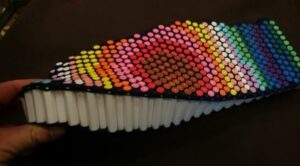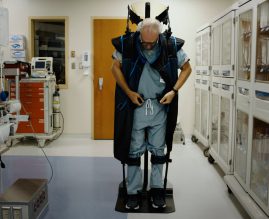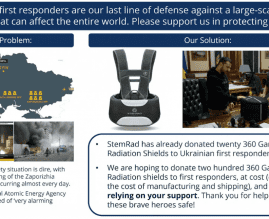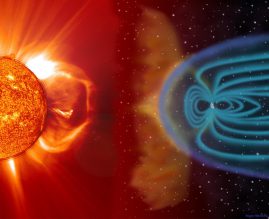Radiation Shielding in Space
12.22.21 | Wednesday | Nofit Amir
Blocking space radiation is one of the critical concerns for the continued human presence in deep space.
Deep space radiation environment consists of low-flux density but highly energetic galactic cosmic rays and the random burst of energetic particles from the Sun, known as solar energetic particles.
The combined space radiation environment can cause short-term and long-term effects such as acute radiation-borne syndromes and long-term consequences such as cardiovascular disease, central nervous system disease, and cancer.
Radiation from Solar Particle Events
When encountered outside the protective barrier of the spacecraft, solar particle events can even cause death.
The high cumulative dose of solar particle events can even cause death when astronauts are outside the protection of spacecraft shielding.
There are many methods of blocking space radiation. They are active methods of radiation shielding and passive methods of radiation shielding. Active methods of space radiation shielding employ electric/magnetic fields to deflect the charged particles away from the crew volume before interacting with the spacecraft material.
Theoretically, active shielding is the best possible solution since active shielding reduces the possibilities of secondary particle generation.
Although, the application of active shielding in space-like conditions is challenging from an engineering point of view. The amount of electric/magnetic field required to deflect highly energetic charged particles is in the range of hundreds of megavolts. Although some advanced research is going on to reduce the magnitude of electric/magnetic fields to make active shielding a reality, they are still conceptual. Therefore, the only viable alternative is passive shielding.
Shielding Material of Choice for Space Radiation
For space radiation shielding, low Z materials with a low density of neutrons and the highest density of electrons per atom are preferred.
Hydrogen is the best material for shielding against space radiation as it has the highest density of electrons per nucleon and no neutrons. An effective radiation shielding material should be stable and withstand impacts that can be encountered in space. Hydrogen as a material is unstable.
Therefore, the best alternative would be any hydrogenous materials such as structurally stable polymers. Many materials have been investigated in the past, such as aluminum, Kevlar, polyethylene, etc. The best radiation shielding material depends on the radiation environment.
The requirement of radiation protection will be different from proton and heavy-ion environments such as the free space environment to electron-rich environments such as the atmosphere of Jupiter.
There have also been some concepts on using soils of Mars and the Moon to build temporary habitats using robotic/automated tools. These ideas can be a reality soon for the sustenance of human lives on the surface of the solar bodies like the Moon or Mars.
Space Radiation Vests
There are also the concepts of radiation protective vests which can be important, especially from the point of view of protecting astronauts against incoming large solar particle events in free-space or against solar particle events on the Martian or Lunar surface when they are outside the protection of the habitat.
These radiation protective vests can provide protection to the astronauts and allow them to do critical mission-related works outside the protection of material shielding both in free-space and during surface stay. AstroRad is an example of such a solution. Its shielding components are comprised of low Z materials such as High Density Polyethylene.
The drawback with such a material is its rigidity. This is overcome in the AstroRad solution by hexagon-based assemblies comprised of thousands independent hexagonal column embedded in an elastic textile, as shown in the image below.
An AstroRad shielding panel. Comprised of thousands of independently moving hexagonal columns, the AstroRad is based on rigid low-Z materials yet enables mobility of the wearer. Additionally, this structure allows for accounting of the body’s self-shielding attributes by implementing specific length hexagons for each point on the torso, based on the thickness and density of the underlying tissue at that point.
Frequently Asked Questions
What can stop radiation in space?
Space radiation is mainly composed of energetic charged particles. To shield against this type of radiation, low atomic mass materials with a low density of neutrons and a high density of electrons per atom are preferred. Hydrogen has no neutrons and at least double the ratio of electrons to atomic mass versus any other element. Thus, high density materials which are rich in hydrogen, such as HDPE, which is used in the StemRad AstroRad vest, are very effective at stopping space radiation.
Is there radiation in deep space?
Yes, deep space is filled with radiation. Galactic cosmic radiation (GCR) consists of high-energy but low-intensity ionized atoms spanning the entire periodic table and originates from outside of the solar system. Solar energetic particles (SEPs), consist mainly of medium-energy and high-intensity protons released by the Sun during sporadic solar storms.
Can radiation penetrate a space suit?
Yes, standard space suits consist mainly of fabric which is not effective at shielding against radiation. This is why it is necessary for astronauts to have dedicated radiation protection solutions in the event of a solar storm in deep space.
How do astronauts survive radiation in space?
The health effects of exposure to radiation in space become more severe with a greater amount of exposure. Today, most astronauts stay onboard the ISS, which is protected by the Earth's magnetic field. Astronauts who stay on the ISS for 1 year will receive on average 300 mSv of radiation, which is equivalent to approximately 50 chest CT scans. The crew of the Apollo Moon missions recorded an average dose of close to 5 mSv for each astronaut, similar to a single chest CT scan, as there were no solar storms during any of the Apollo missions. Thus, humans have so far not been exposed to life-threatening radiation doses in space. However, with NASA's new Artemis program to send humans back to the moon for multiple weeks at a time, they would not have the protection of Earth's magnetic field in the event of a solar storm, and will need additional protection in order to prevent acute radiation syndrome or a significantly increased risk of cancer.
Can humans survive space radiation?
The health effects of exposure to radiation in space become more severe with a greater amount of exposure. For exposures between 100 and 1000 mSv, an astronaut would experience an increased lifetime risk of cancer, while exposures beyond 2000 mSv would lead to acute radiation syndrome. An exposure of 5000 mSv would kill half of the people exposed within one month, while an exposure of 10000 mSv should be fatal within several days. During a particularly strong solar storm, an astronaut could be exposed to up to 500 mSv.
What protects Earth from cosmic radiation?
Earth's surface is protected from cosmic and solar radiation first by the geomagnetic field, which deflects most incoming particles, and second by the atmosphere, which absorbs much of the remaining particles which make it through the magnetic field.

Writes content for StemRad’s website, social media, and newsletter. She is an advocate with over twenty years of experience of writing high-end content in academic and industrial settings.



